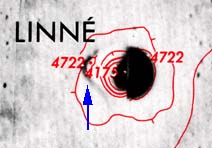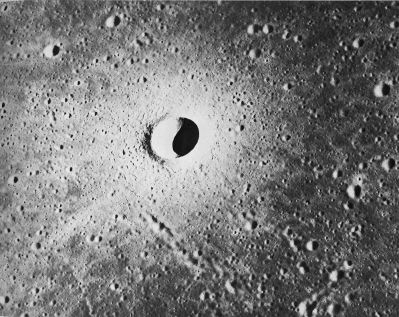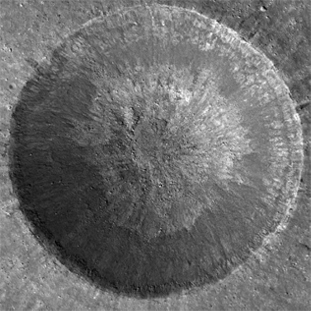Linné
Contents
[hide]Linné
|
Lat: 27.73°N, Long: 11.79°E, Diam: 2.23 km, Depth: 0.6 km, Rükl 23, Copernican | |
Right: LROC view NAC M122129845 (see also LROC article below).
Images
LPOD Photo Gallery Lunar Orbiter Images Apollo Images
Maps
(LAC zone 42A4) USGS Digital Atlas PDF LAC map Geologic map LM map LTO map
Description
A typical fresh craterlet on a low hill, blanketed by bright ejecta. There are many other features in this class, a few examples (quoting from the Ashbrook article) being Lassell D, Werner D and Posidonius Gamma. - JimMosher
Is the brightness of this kind of high-albedo ejectablankets in some way related to the sun's altitude above the lunar surface? (the angle sun-ejectablanket-observer). Is the Full Moon's strong retro-reflection on the low-albedo regolith (around this kind of high-albedo ejectablankets) capable of creating the illusion of "uniform looking brightness" of a larger area? (in other words: the sun's retro-reflection on the surrounding regolith looks as bright as the high-albedo ejectablanket, and eliminates the bright look of that blanket). - DannyCaes Aug 23, 2015
Elger
(IAU Directions) LINNE.--A formation on the W. side of the Mare Serenitatis, described by Lohrmann and Madler as a deep crater, but which in 1866 was found by Schmidt to have lost all the appearance of one. The announcement of this apparent change led to a critical examination of the object by most of the leading observers, and to a controversy which, if it had no other result, tended to awaken an interest in selenography that has been maintained ever since. According to Madler, the crater was more than 6 miles in diameter in his time, and very conspicuous under a low sun, a description to which it certainly did not answer in 1867 or at any subsequent epoch. It is anything but an easy object to see well, as there is a want of definiteness about it under the best conditions, though the minute crater, the low ridges, and the nebulous whiteness described by Schmidt and noted by Webb and others, are traceable at the proper phase. As in the case of Hyginus N, there are still many sceptics as regards actual change, despite the records of Lohrmann and Madler; but the evidence in favour of it seems to preponderate.
Wikipedia
Additional Information
- IAU page: Linné
- Depth data from Kurt Fisher database
- Pike, 1976: 0.6 km
- Arthur, 1974: 0.47 km
- Westfall, 2000: 0.6 km
- Viscardy, 1985: 0.6 km
- Cherrington, 1969: 0.48 km
- Thermal anomaly crater, implying youthful age - Moore et al, 1980
 On LTO 42A4Linné is shown with a strange elliptical shape, having an odd raised lip on the western side (blue arrow in this detail). Note also the discontinuous contours. This seems to be a flaw in the preparation of this particular LTO. No other image, including Apollo 15 Metric Camera photos 404, 406 and 408, on which this particular LTO is supposed to be based, shows Linné as anything other than a simple circular crater.
On LTO 42A4Linné is shown with a strange elliptical shape, having an odd raised lip on the western side (blue arrow in this detail). Note also the discontinuous contours. This seems to be a flaw in the preparation of this particular LTO. No other image, including Apollo 15 Metric Camera photos 404, 406 and 408, on which this particular LTO is supposed to be based, shows Linné as anything other than a simple circular crater.
- In a sense, LTO 42A4 is only the latest in a long list of changes in the reported form of Linné, beginning with J.F.J. Schmidt's 1866 observation that the previously normal crater at this position had mysteriously morphed into a bright blob. That story is told in a column by former Sky and Telescope editor Joseph Ashbrook. Although the possibility of ongoing changes in the shape of Linné was debated by Wilkins and Steavenson as recently as 1954, the modern view has tipped away from Elger's interpretation of differences in reports as evidence of a changing Moon. In the words of selenologist Richard Pike, Linné is "an extremely fresh but otherwise quite ordinary impact crater" on the summit of a small hill covered by a blanket of bright ejecta. Ashbrook puts the height of the hill at about 100 meters. Like other features in its class, its appearance changes dramatically depending on the angle of the lighting. Ashbrook accepts as a confirmed fact the circa 1900 observation of L. Brenner that "the eastern wall of the craterlet is noticeably thicker and higher than the western." This seems opposite to the way the crater is portrayed in LTO 42A4, but it is possible the preceding statement was inadvertently repeated in pre-IAU directions, and perhaps knowledge of this observation influenced the contorted way Linné is portrayed on the LTO. In any event, Ashbrook found abundant evidence of Linné being seen as a bright patch long before Schmidt's 1866 observation. - JimMosher
- 2.5-km diameter Linné is cited in Melosh, 1989 (pp. 14-16 and Fig. 2.2) as the archetype of a simple bowl-shaped crater with nearly parabolic inner walls (increasing smoothly in slope towards the top) and "no central flat floor". The smoothly-curved shadow in the Apollo panoramic frame shown above seems more-or-less consistent with this interpretation, however the higher Sun shadow in the ASU scan of Apollo Metric photo AS15-M-0845 clearly demonstrates the existence of a substantial area of flat floor at the bottom (hidden in shadow in the panoramic shot). The bullet-like shape of the shadow also suggests the walls may be more nearly conical (constant slope) than parabolic. - JimMosher
Nomenclature
- Named for Carl Linnaeus, Latinized as Carolus Linnaeus, also known after his ennoblement as Carl von Linné, (May 23, 1707 – January 10, 1778), a Swedish botanist, physician and zoologist who laid the foundations for the modern scheme of nomenclature for living organisms.
- Linné Alpha, a large flat dome northwest of Linné itself, is known as the Valentine Dome (nicknamed by Alika Herring of Sky and Telescope).
LROC Articles
LPOD Articles
Lunar 100
L82: Small crater once thought to have disappeared.
Bibliography
- Apollo Over the Moon, Chapter 5: Craters (Part 1), Figure 102.
- Ashbrook, J. "Linné in fact and legend". Sky and Telescope, August, 1960, p. 87. Reprinted in The Astronomical Scrapbook (Cambridge University Press, 1984), Ch. 53. According to Ashbrook, "a full bibliography of the lunar crater Linné would contain several hundred titles".
- Moore, P. 1965. Variations on the Surface of the Moon: an Evaluation. Irish Astronomical Journal, vol. 7, pp. 106-113. (on pp. 106 - 108).
- Steavenson, W. H. 1954. The Lunar Crater Linné. JBAA 64, p. 316.
- Wilkins, H. P. 1954. Linné. JBAA 64, pp. 86-87.
The lunar crater Linné in the Sourcebook Project (William R. Corliss)
- In Mysterious Universe, a handbook of astronomical anomalies (1979):
- On the Obscuration of the Lunar Crater "Linné" (W.R.Birt, American Journal of Science, 1867).
- The Linné Controversy: a look into the past (P.Moore, Journal of the British Astronomical Association, 1977).
Dutch observation of a strange bright glow near Linné
- On page 139 of the very interesting book 40 JAAR UFO's by Hans van Kampen (De Kern, 1987) (a book about the odd history of ufology):
- September 1973. During this month the author Hans van Kampen and a certain gentleman Van Cleef observed the moon through van Kampen's telescope, and noticed a strange bright glow near Linné (duration of the bright glow; something of two minutes).
- I must say, from what I have seen here in that book, both Hans van Kampen and Van Cleef seem to have been not very familiar with selenography. Because van Kampen wrote about Linné: "approximately in the neighbourhood of the first manned lunar landing".
Named Features -- Prev: Lindsay -- Next: Liouville

